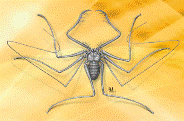Papers in the Biological Sciences

Eileen Hebets Publications
Document Type
Article
Date of this Version
2009
Abstract
Animals present an enormous variety of behavioral defensive mechanisms, which increase their survival, but often at a cost. Several animal taxa reduce their chances of being detected and/or recognized as prey items by freezing (remaining completely motionless) in the presence of a predator. We studied costs and benefits of freezing in immature Eumesosoma roeweri (Opiliones, Sclerosomatidae). Preliminary observations showed that these individuals often freeze in the presence of the syntopic predatory spider Schizocosa ocreata (Araneae, Lycosidae). We verified that harvestmen paired with predators spent more time freezing than when alone or when paired with a conspecific. Then, we determined that predator chemical cues alone did not elicit freezing behavior. Next, we examined predator behavior towards moving/non-moving prey and found that spiders attacked moving prey significantly more, suggesting an advantage of freezing in the presence of a predator. Finally, as measure of the foraging costs of freezing, we found that individuals paired with a predator for 2 h gained significantly less weight than individuals paired with a conspecific or left alone. Taken together, our results suggest that freezing may protect E. roeweri harvestmen from predatory attacks by wolf spiders, but at the cost of reduced food and/or water intake.


Comments
Published in Behavioural Processes 82:2 (October 2009), pp. 153–159; doi: 10.1016/j.beproc.2009.06.001 Copyright © 2009 Elsevier B.V. Used by permission.